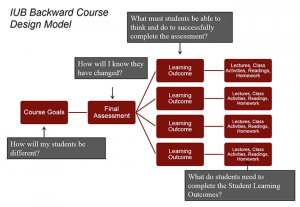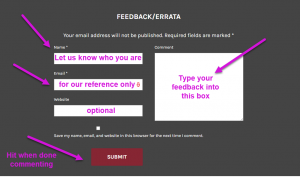Section 1: Assessment Methods & Backwards Design
Section 1 provides an overview of assessment methods and the leading method of how to build strong assessments. You will not need any specific materials.
This section should take 1 – 2 hours to complete.
Guiding Questions
Please think about these questions before you begin this section:
- What is your biggest concern regarding assessment in online courses?
- In your courses, what kinds of learning are particularly difficult to measure, and why?
Three Methods of Assessment
Assessment is “the process of using tools and techniques to collect information about student learning. In other words, assessment is the way teachers see their students’ learning” (Gareis & Grant, p. 2, 2015).
We use assessment to determine the “nature and degree of student learning” (Garies & Grant, p. 3, 2015).
There are three methods of assessment:
Pre-Assessment occurs before you teach your students.
Formative Assessment includes ungraded activities and feedback you provide to students.
Summative Assessment involves graded activities that occur at the end of learning.
- Each method of assessment has a purpose in your classroom. We use pre-assessment to evaluate the needs of our learners before we teach them. For example, you may survey your students before a lecture to see if they understand a concept they should have learned in a previous class. If your students can answer it with ease, you don’t need to spend a lot of time reviewing it.
- Formative assessment is used throughout the term and can take multiple forms, such as an answer you provide to a student’s question, practice questions, quizzes, written feedback on assignments, or verbal feedback. Formative assessment is intended to inform learning so students can grow.
- We use summative assessment to translate student learning into a scale and understandable unit of measure. Summative assessment is intended to be a summary of student learning.
- We will be focusing on summative assessment for the purposes of this Module. However, you will have the opportunity to include pre-assessment and formative assessment in your activities.
Achieving Effective Assessment
Assessment needs to align with your curriculum (course content) and instruction (teaching methods). Scroll your mouse over the question marks in the diagram to learn more.
Figure 7.
Ellis, D. (2007). Aligning learning outcomes, assessments and teaching methods. Teaching Excellence Academy workshop for University of Waterloo, Canada. Retrieved from Queens University, Matching Assessment Tasks to Learning Outcomes.
The Cycles of Assessment
We also use the practice of assessment, as a whole, to inform our teaching. By looking at assessment as a cycle throughout the duration of a class, we can begin to see how assessment informs our teaching and learning activities. For every assessment[ we create, we want to engage in a cycle that has four stages (scroll over the question marks below).
In this approach, we begin with the end in mind. This is also known as understanding by backwards design (UbD).
Understanding by Backwards Design (UbD)
Using the Backwards Design approach will help you align your assessment, curriculum, and instruction.
Backwards Design is a learning theory for designing sound pedagogical courses by starting with the learning outcomes first, rather than starting with your course activities. Please consider the diagram below to gain an understanding of how UbD can help you design good activities and assessments.

Indiana University Bloomington. (n.d.). IUB backward course design model. [Infographic]. Retrieved April 16, 2020 from https://citl.indiana.edu/teaching-resources/course-design/backward-course-design/index.html.
Extended Activity: Watch this video to review the methodology and purpose of backwards design. (8 min)
Another important aspect of backwards design is that it helps ensure your assessment is authentic. All authentic assessment starts with alignment to intended learning outcomes. When we need to change our assessment and/or learning activities, it may feel daunting. And in the face of a new teaching environment (e.g., online), it becomes clear just how crucial it is that we create authentic, pedagogically sound assessments.
What is Authentic Assessment?
As you have been transitioning to online teaching, you have undoubtedly thought about how you will accurately assess your students’ learning. Questions about how to do this properly while maintaining academic integrity in your virtual classroom may be plaguing you. The good news is that maintaining authentic assessment practice is probably less work than you think! The bad news is that it will still take some work.
 TIP: the more opportunities your students have to demonstrate learning of an outcome, the more reliable your assessment is.
TIP: the more opportunities your students have to demonstrate learning of an outcome, the more reliable your assessment is.
There are two main components of authentic assessments: validity & reliability:
A valid assessment is one that is “truthful, suitable, legitimate, applicable, convincing, compelling” (Gareis & Grant, p. 24, 2015).
A reliable assessment is one where “the consistency or dependability of the results of the assessment” are maintained (Garies & Grant, p. 37, 2015).
 TIP: when building an activity for assessment (e.g., exam) try asking 2 – 3 questions that evaluate the same learning outcome. This gives students multiple chances to demonstrate their understanding of a particular content area.
TIP: when building an activity for assessment (e.g., exam) try asking 2 – 3 questions that evaluate the same learning outcome. This gives students multiple chances to demonstrate their understanding of a particular content area.
Authentic assessment is achieved when you have considered the perspective of your student and built your assessment after you have created well-thought-out learning outcomes.
![]() Here is a friendly reminder from our friend, Louis Pasteur:
Here is a friendly reminder from our friend, Louis Pasteur:
Chance favours the prepared mind
- Next, we will move into Section 2: Types of Scoring Criteria
Extended Resources
Bowen, R. S. (2017). Understanding by design. Vanderbilt University Center for Teaching. Retrieved April 11, 2020, from https://cft.vanderbilt.edu/understanding-by-design/.
Queens University (n.d.). Assessment types: Diagnostic, formative and summative. Retrieved April 11, 2020 from https://www.queensu.ca/teachingandlearning/modules/assessments/09_s2_01_intro_section.html.
Queens University. (n.d.). Deciding what to assess. Retrieved April 11, 2020 from https://www.queensu.ca/teachingandlearning/modules/assessments/05_s1_02_deciding_what_to_assess.html.
References
Bowen, R. S. (2017). Understanding by design. Vanderbilt University Center for Teaching. Retrieved April 11, 2020 from https://cft.vanderbilt.edu/understanding-by-design/.
Gareis, C. R. & Grant, L. W. (2015). Teacher-made assessments: How to connect curriculum, instruction, and student learning (2nd ed.). Routledge.
Indiana University Bloomington. (n.d.). IUB backward course design model. [Infographic]. Retrieved April 16, 2020 from https://citl.indiana.edu/teaching-resources/course-design/backward-course-design/index.html.
Queens University. (n.d.). Matching assessment tasks to learning outcomes. Retrieved April 11, 2020 from https://www.queensu.ca/teachingandlearning/modules/assessments/18_s2_10_revisiting_learning_outcomes.html.
Feel free to leave any feedback you may have about the design, structure, or content of this module. We appreciate feedback because we are always learning!

any method you use to determine the nature and degree of student learning.
method of assessment to determine learner knowledge prior to teaching
ungraded method of assessment
graded method of assessment
educational theory for designing courses by starting with learning outcomes first, then creating assessments, and course activities.
What your students will know and skills they will learn by the end of the course.

